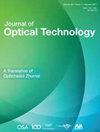三维螺旋微结构形状偏差对近衍射区涡束性能的影响
IF 0.6
4区 物理与天体物理
Q4 OPTICS
引用次数: 1
摘要
研究主题。研究了螺旋微结构形状和位置的各种偏差与制造误差和对准误差对在近衍射区(约十几个波长的距离)形成的涡旋光束性能的影响。研究目的。目的是确定不同类型的形状偏差和螺旋微结构位置对形成的涡旋光束性能的影响。方法。采用时域有限差分法对线性和非线性螺旋相板进行了数值模拟,考虑了所研究元件在复杂表面上的反射和折射等三维结构的真实特征。在一系列数值实验中,改变了微浮雕的高度、照射光束的半径及其位移。主要的结果。结果表明,与螺旋微观结构的三维形状偏差,如浮雕的非线性,会导致相涡依赖性的畸变,从而破坏成形梁的环形强度。然而,在这种情况下,奇异光束结构的整体稳定性得到了保留,而在照明光束与光学元件不对准的情况下,奇异光束结构的整体稳定性被完全破坏。微凸高度的变化会导致拓扑电荷和光束形状的变化。对于输入高斯光束孔径半径的影响,可以通过改变孔径半径对形成的涡流光束进行缩放。光学系统的失准会导致涡旋光束的环形结构及其不变性的丧失。现实意义。所获得的结果可用于涉及可调光学元件的应用,以及在光敏介质中形成的微结构。形成的光束结构畸变的主要原因包括蚀刻过程中的工艺误差,如衍射光学元件的高度不匹配和区域结构的变化,以及光学系统的对准误差,如照明光束和光学元件的不对准。需要注意的是,三维光学元件的结构特性对近区衍射图样的影响最为显著。本文章由计算机程序翻译,如有差异,请以英文原文为准。
Influence of 3D helical microstructure shape deviations on the properties of a vortex beam generated in the near diffraction zone
Subject of study. The effect of various deviations of the helical microstructure shape and position associated with manufacturing and alignment errors on the properties of vortex beams formed in the near diffraction zone (at a distance of about a dozen wavelengths) has been studied. Aim of study. The aim is to determine the influence of different types of shape deviations and the spiral microstructure position on the formed vortex beam properties. Method. Numerical simulation was performed using the finite-difference time-domain method with both linear and nonlinear spiral phase plates, allowing the real features of the 3D structure of the element under study to be taken into account with respect to reflection and refraction on a complex surface. The height of the microrelief, the radius of the illuminating beam, and its displacement were varied in a series of numerical experiments. Main results. It was shown that 3D shape deviations from the helical microstructure, for example, nonlinearities of the relief, lead to a distortion of the vortex dependence of the phase and break the annular intensity of the formed beam. However, in this case, the overall stability of the singular beam structure is preserved, which is completely destroyed in the case of misalignment of the illuminating beam and the optical element. A change in the height of the microrelief leads to a change in both the topological charge and the shape of the beam. As for the influence of the aperture radius of the input Gaussian beam, it is possible to scale the formed vortex beams by changing the aperture radius. Misalignment in the optical system leads to the loss of the annular structure of the vortex beam and its invariant properties. Practical significance. The obtained results can be useful in applications involving adjustable optical elements, as well as microstructures formed in photosensitive media. The main reasons for the distortion of the formed beam structure include both technological inaccuracies during etching, such as the height mismatch and changes in the structure of the zones of the diffractive optical element, and alignment errors of the optical system, such as the misalignment of the illuminating beam and the optical element. It should be noted that the characteristics of the 3D optical element structure most noticeably affect the diffraction pattern in the near zone.
求助全文
通过发布文献求助,成功后即可免费获取论文全文。
去求助
来源期刊
CiteScore
0.90
自引率
25.00%
发文量
66
审稿时长
3-8 weeks
期刊介绍:
The journal publishes design details of a diversity of optical instruments, along with a strong section on computational optics useful to engineers, mathematicians, and physicists, as well as optical scientists. Issues of the English translation volume are published by OSA and appear at the same time as the Russian language edition, Opticheskii Zhurnal, which is produced by the Vavilov State Optical Institute

 求助内容:
求助内容: 应助结果提醒方式:
应助结果提醒方式:


